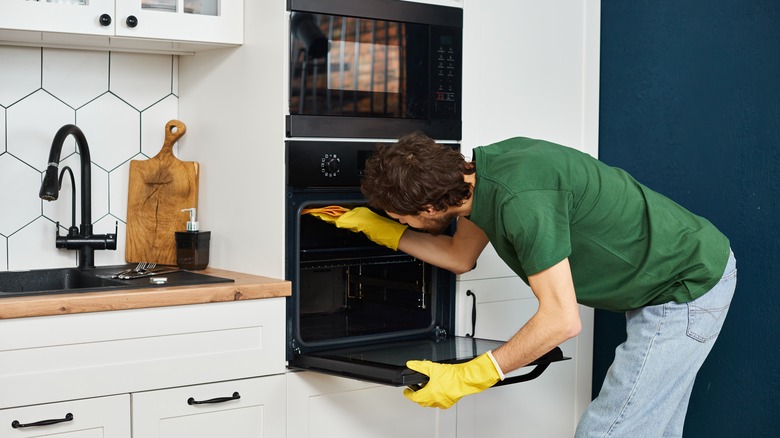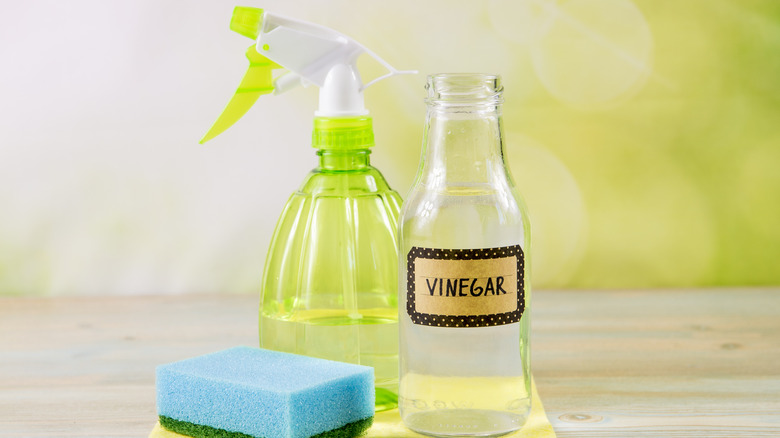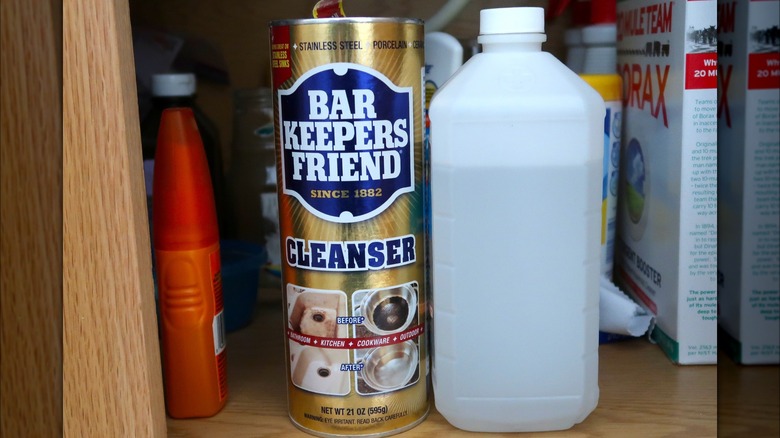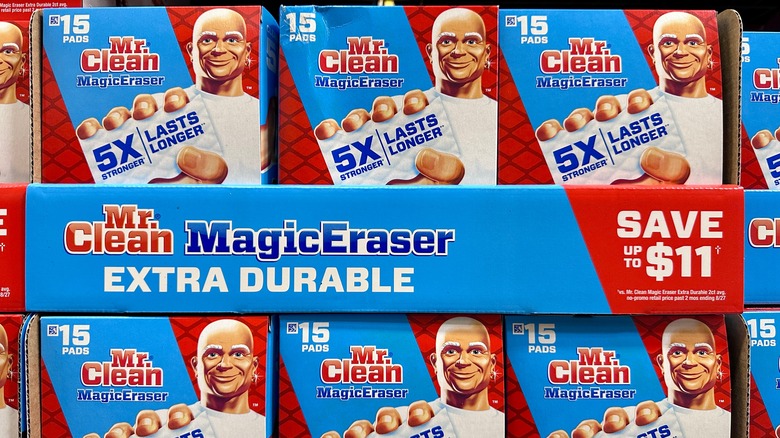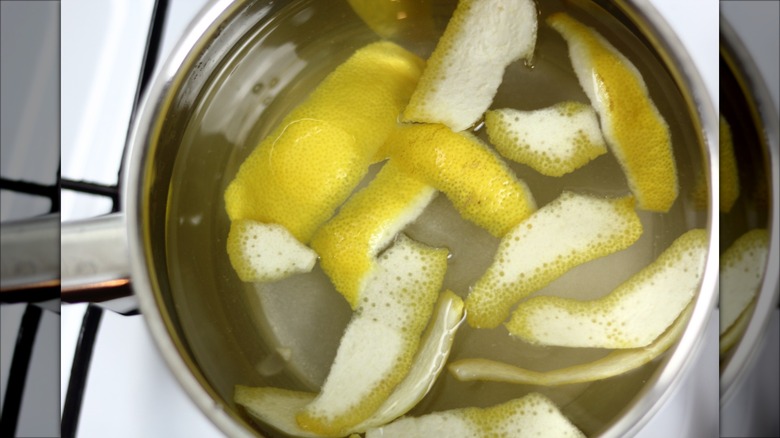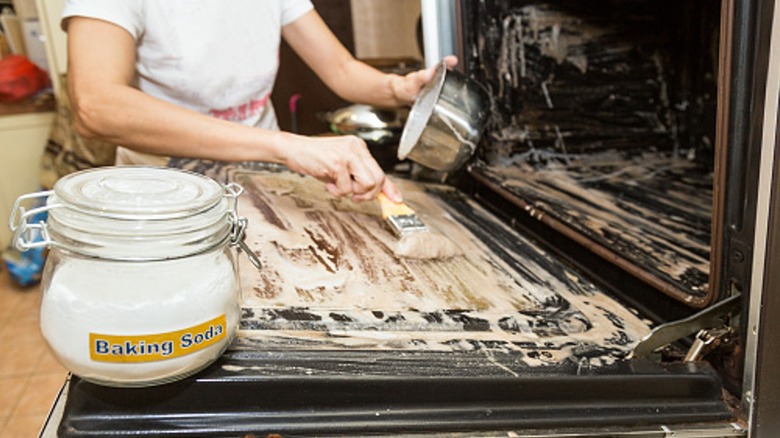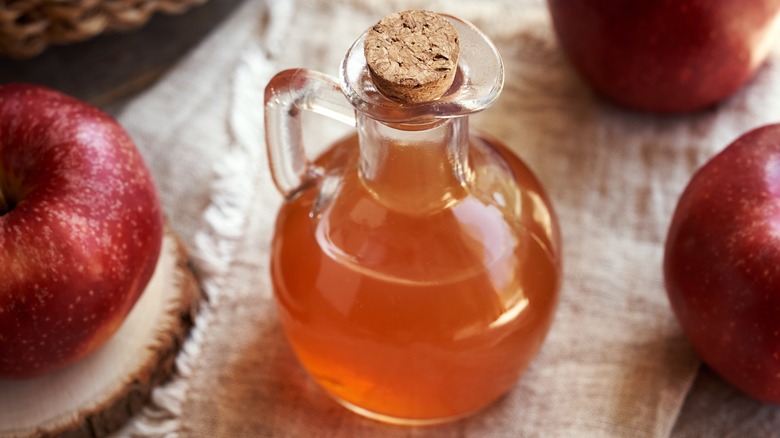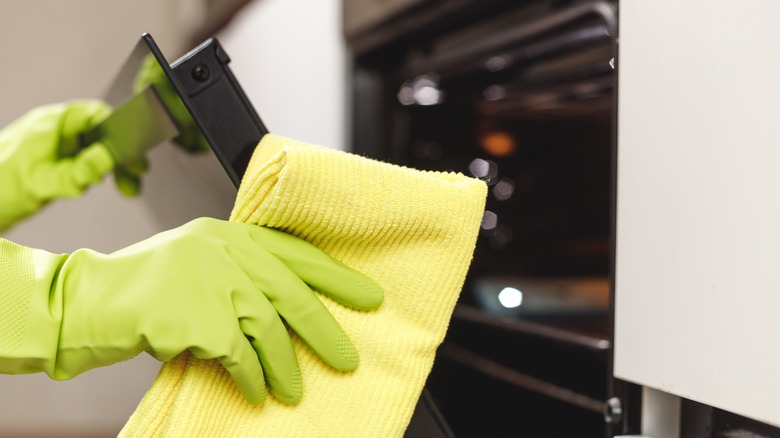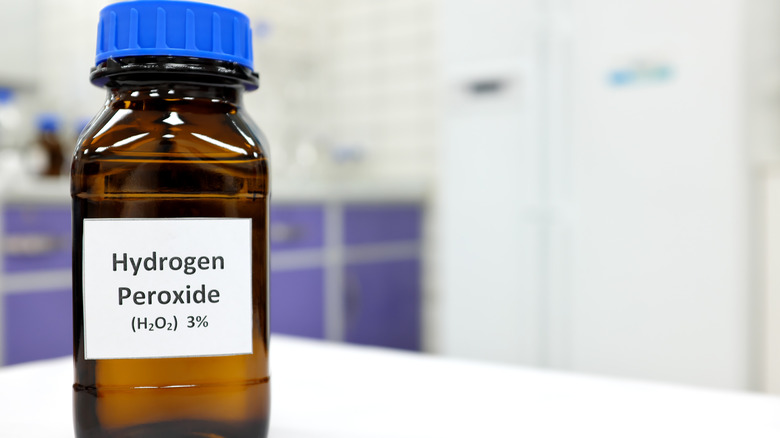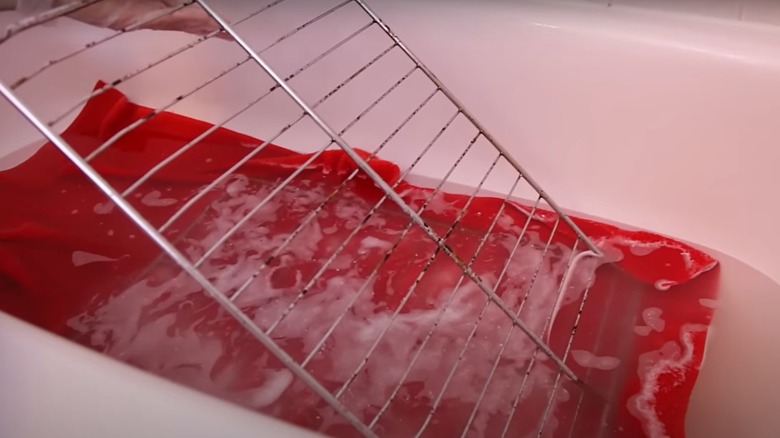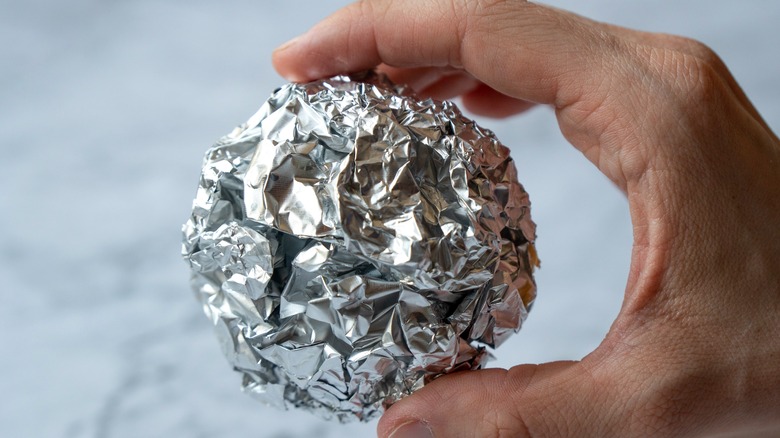10 Clever Cleaning Tips & Tricks For A Sparkling Oven
We may receive a commission on purchases made from links.
No one likes a dirty oven. However, it is probably also safe to say that no one likes cleaning their oven. While you can buy oven cleaner at the store, it isn't always the best solution. These chemical cleaners have a very high pH. While this makes them effective at breaking down all the burnt-on messes in an oven, it also makes them caustic. This means they have the potential to irritate or even burn your skin. Plus, many oven manufacturers advise against using these chemical cleaners in their units.
So, if you can't use oven cleaner, and you don't want to spend an entire day scraping and scrubbing off accumulated food messes, what are you supposed to do? Fortunately, there are several tips and tricks that can help you achieve a sparkling oven with relative ease. Read on to learn more, and perhaps you'll find the inspiration you need to go tackle the mess that's waiting for you.
Steam clean your oven using vinegar and water
Vinegar is a versatile cleaning product that can be used around the home. And, one of the top ways to use it in the kitchen is for cleaning the oven. However, the way you use the liquid here looks different than it does for other surfaces. Instead of wiping the appliance directly with a sponge or rag saturated with the liquid, you can steam cleaning the oven using vinegar.
Start by emptying the oven of everything, including the racks. Then, set the oven to 300 degrees Fahrenheit and add water and vinegar to an oven safe bowl (in a 1:1 ratio). Leave the door closed for about 30 minutes to 1 hour, and the hot oven will heat up the liquid, generating steam to loosen all the gunk. Finally, remove the bowl of liquid from the oven and let the interior cool a bit before wiping it down. You may have to repeat the process and wipe the interior again for particularly dirty ovens.
The reason this tip works so well all boils down to — pun intended — the vinegar. As you may know, vinegar contains about 5% acetic acid. This helps it to remove mineral deposits, soap scum, and other gunk from many surfaces throughout the home.
Try some Bar Keepers Friend to break down messes
If you've never used Bar Keepers Friend, then you've been missing out. This versatile cleaner, which is available on Amazon, can be used to clean a wide variety of surfaces including stainless steel, ceramic, glass, copper, tile, and, yes, even the oven. The secret ingredient in this cleaner is the oxalic acid, a naturally occurring compound found in several vegetables and fruits. This works as a brightening agent, removing built up rust, stains, and other grime.
Start by using a wet sponge to wipe down the inside of the oven to get it damp. Then, make a paste by combining some of the powdered Bar Keepers Friend with a little hot water. Use a sponge to spread the paste over the inside of the oven, let it work for about a minute, and wipe everything down to remove burnt-on food messes and the excess cleaning agent. Depending on how dirty your oven is, you may find that you need to repeat the above steps a few times. If needed, you can also add some of the paste to a scouring pad to tackle particularly stubborn gunk or grime.
While Bar Keepers Friend is authorized by the National Sanitation Foundation for use in commercial food processing facilities, it is still important to thoroughly rinse the oven after cleaning it. Use a damp sponge to wipe the inside of the oven, rinsing it several times as you work to ensure all residue of the cleaner is removed before cooking again. The company also says that, after cleaning and rinsing the residue away, you can leave your oven set to 400 degrees for about 10 minutes to bake off any lingering residues or odors from the cleaner.
Use a Magic Eraser to erase grime from the oven door
You've probably seen the commercials for Magic Erasers. You may even have one in your cleaning arsenal right now. But, did you know that this little tool could also help you clean the oven? While a Magic Eraser might seem like magic, its cleaning power lies in the abrasive melamine foam that makes it up. As you rub surfaces, such as the oven or oven door, with this foam, it creates friction, helping to get rid of grime and stains. Magic erasers can be used dry or wet. When you add water to them, the melamine foam micro triangles harden significantly.
Because of these properties, you may find success using a Magic Eraser to clean your oven. However, don't expect the grime to simply wipe away with a single pass. You'll need to exert a good deal of elbow grease, and might find greater success adding in some Dawn dish soap. Alternating between a wet and dry Magic Eraser to take clean of the different cleaning abilities of each could also be effective. Depending on the state of your oven and how much force you're able to exert, you may find greater success than you would using the rough side of a sponge.
Heat up lemon water to loosen gunk and grime in the oven
Have you heard about the microwave-cleaning hack that uses just a lemon and a bowl of water? Well, these same two ingredients may also be able to help you loosen the gunk in your oven naturally so that it's easier to wipe it clean. Lemon steam sounds like something you may be offered at the day spa, but in this case, it is the special combination that will come to the rescue when cleaning the oven.
You'll need an oven-safe dish or baking pan partially filled with water. Then, slice a few lemons and add them to the bowl (or squeeze in their juice), and put it in the hot oven. Let the oven warm the water and lemon juice to create steam for about an hour before turning off the oven and letting it cool most of the way. Then, use a sponge or microfiber cloth to wipe all the grime that the lemony steam loosened for you. You may need to repeat the process if you find you can't get all of the grime off with a simple wipedown. Or, combine this with another method, like the Magic Eraser, for very grimey ovens.
Lemons are a versatile cleaning product. As an acid, they offer antibacterial and antiseptic properties to leave the surfaces in your home clean. Moreover, they are also excellent at cutting through grease and grime, which is what makes this trick so effective.
Make a baking soda paste to banish rust in an oven
If rust has started taking over your oven, you want to remove the reddish brown mess before it does the appliance in for good. Are you wondering how the rust got in your oven in the first place? It has to do with a chemical reaction that occurred after the iron or steel in the appliance came into contact with both oxygen and water for a prolonged period of time.
As unsightly as rust is, there is a relatively simple method for removing it from your oven. And, it is probably sitting in a cabinet not too far from the oven right now. That's right, the secret rust-removing ingredient is baking soda. Try making a paste by adding just enough water to the powder to make it damp and thick. Spread the paste over the affected sections of the oven and then scrub them using a damp scouring pad. Continue adding more of the baking soda paste until the rust is gone. If the paste doesn't seem sufficient, you could also try a combination of baking soda and vinegar to get rid of the rust. As an acid, the vinegar can help to dissolve it, and baking soda's abrasive properties will help you scrub any remaining residue away.
Try a combination of apple cider vinegar and sugar to cut through grease in the oven
Another combination of ingredients that are likely sitting in your pantry right now may also come in handy if you're trying to remove thick and yucky grease from your oven: apple cider vinegar and sugar. Vinegar is well-known for its cleaning abilities. It can be used on a variety of surfaces throughout the home by making a DIY spray by combining it with equal parts water. As a disinfectant, the vinegar will help leave your oven clean and safe to use for future cooking tasks.
Now, you may be wondering what role sugar plays in this cleaning hack. Well, it works as a mineral abrasive. These have a very rough texture, which helps them remove stuck-on messes through creating friction. To clean your oven using apple cider vinegar and sugar, add about 2 to 2 ½ tablespoons of sugar to a cup of vinegar. Pour the DIY cleaner in the bottom of a warm oven, and spread it around. After an hour has passed, use a sponge to scrub the sugar granules in and remove any remaining gunk before wiping the oven clean. You may have to rub the sugar longer on any tough spots or add an extra sprinkle for more abrasive cleaning power.
Use a microfiber cloth and a lime to clean the oven's glass door
There are two budget-friendly items that can clean your glass oven door: a microfiber cloth and a lime. This may sound like a bit of an odd pairing, but each item has a specific job, and the two really work well together to cut through grease and grime. To start, limes are acidic. Cleaning experts take advantage of this to cut through greasy messes. Limes also offer a pleasant citrus scent, so after you've finished cleaning your oven, it should also smell wonderful.
Microfiber cloths are a top cleaning product that are made up of tons of thin split micro fibers. This composition makes these especially absorbent and ideal for soaking up water and cutting through gunk. Because of how many tiny threads make up a microfiber cloth's surface area, the cleaning power can be equivalent to a standard cotton cloth that is four times as big. So, as you're cutting through the grease and grime with the lime, the microfiber cloth will help remove it all from the door. Plus, because of how absorbent it is, you shouldn't need to interrupt yourself to wring it out as often.
Keep the oven and door clean with the help of some hydrogen peroxide
Hydrogen peroxide can come in handy for keeping your oven door clean and free of potentially dangerous bacteria or viruses. While you could try using hydrogen peroxide on its own, you will likely find that it is most effective when combined with the power of baking soda. Cleaning experts recommended starting by making a paste with baking soda, hydrogen peroxide, and a little bit of dish soap. Apply this mixture over the greasy sections in your oven and let it sit for at least 12 hours, or overnight. After 12 hours have passed, you can use a damp sponge to remove all the loosened gunk.
While hydrogen peroxide is not recommended for cleaning wounds as much anymore, it is still a top choice for cleaning several other surfaces in a home. It offers disinfecting properties to eliminate harmful bacteria. Plus, its cleaning abilities will help you make sure your oven is ready for the next meal you want to cook.
Simplify the task of getting gunk off of oven racks by cleaning them in the bathtub
Cleaning the oven racks is often one of the most challenging aspects of cleaning your oven. With all the tight spaces, it can be very hard — and time consuming — to get rid of all the caked on messes. Even worse, because of their open design, anything you wipe away from the racks drops right back into the oven or onto your floors.
The next time you need to clean your oven racks, appliance experts recommend that you remove them from the oven completely and put them to soak with some warm water and dish soap in your bathtub. Soaking the racks will loosen all the gunk in them, so you'll have to scrub less. Plus, since the mess is contained to the bathtub, cleaning it up after you're done with the racks should be much simpler. Just take care. Oven racks are made from metal, so they may scratch your bathtub. To prevent this from happening, just place a few old towels along the bottom.
Ball up aluminum foil and use it to clean the oven
Did you know that you can use aluminum foil for more than cooking or saving leftovers? It can be used to clean your oven, and may be especially helpful when it comes to removing grime. To use aluminum foil to clean the oven racks, spritz them with a little vinegar. Then, rub over the vinegar using a crumpled ball of aluminum foil. The slightly abrasive DIY cleaning tool should help rub against the mess to release it from the grates.
A crumpled up ball of aluminum foil can also help you clean your oven door. Start by covering the grimy door with some baking soda and water. After a few minutes, rub the ball of foil all around. It will work on the baking soda to loosen the grime so that you're able to just wipe it away with a clean cloth or paper towel.
